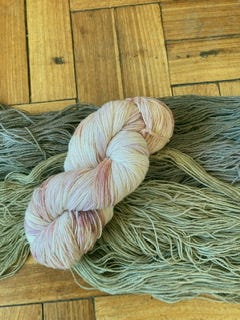I love fall in Ohio: the breathtaking colors, the crisp, fresh quality of the air, the chance to wear sweaters and stand close to the campfire. In central Chile, there are four distinct seasons, and I appreciate them all on their own terms (spring is amazing here!). But fall is just less spectacular here. In fall, I do get to enjoy the beginning of sweater weather, but the colors don’t reach the same intensity (plus we have a lot more trees that don’t change color) and the fall air doesn’t have the same quality. So I love to find the smaller moments that remind me of fall in Ohio.
Sweetgum leaves are one of those small moments. Sweetgum (or liquidambar) is a common urban tree here, so there are several I keep tabs on during my walks around the city. In April, they finally start to show their fall colors, bright reds and yellows to deep, purplish reds, and closer to the end of the month they start to fall, and I collect them. I prefer freshly fallen leaves with the deepest, most saturated color, mostly because it improves the sensory experience of dyeing with them.
Sweetgum leaves, like last month's plant, contain anthocyanin dye compounds, which means that they are highly sensitive to pH and can give several different colors depending on the conditions in the dye pot. The first time I tried using them, I made a dye bath, which was a deep red until I added yarn mordanted with alum and then turned a deep, muted forest green. Then I tried them in a bundle dye, using a skein of yarn mordanted with alum and with cream of tartar added and got this:
When I unwrapped the bundle dye to find this result it was a revelation. The soft pinks fading into corals and warm purples wouldn’t normally feel like a fall color story, but they echo the colors of the leaves themselves and remind me of fall anyway. The freshly steamed bundle smells like fall as well. Working with sweetgum leaves is such a beautiful sensory experience that I look forward to it all year. I collect leaves in April and May (I have to restrain myself- I don’t actually need that many for bundle dyeing and I find them all over the place) and can use them fresh or dried through fall and winter.
When I used wool mordanted with alum but not treated with cream of tartar, I got a range of pastel colors but very little pink. I love the pinks so I always treat with cream of tartar when I want to use sweetgum leaves.


One of my first projects with my own yarn was the Dayspring sweater by Ainur Berkimbayeva (an incredibly creative designer you should check out!) and I used three skeins dyed with sweetgum and touches of cochineal, plus the occasional chamomile flower that snuck its way in. Sweetgum leaves, like all anthocyanins, aren’t particularly washfast, so the color has faded a bit since I finished it last fall, although it is definitely still present. I might eventually dye it again with a new batch of leaves. Instead of seeing the tendency to fade as a negative, I embrace the opportunity to refresh garments that fade or change color, giving them new life, part of the very cycle that fall reminds us of each year.








Beautiful colors, and a lovely pattern.